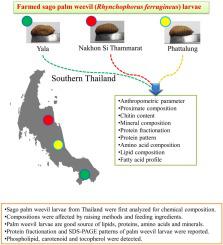当前位置:
X-MOL 学术
›
J. Food Compos. Anal.
›
论文详情
Our official English website, www.x-mol.net, welcomes your
feedback! (Note: you will need to create a separate account there.)
Farm-raised sago palm weevil (Rhynchophorus ferregineus) larvae: Potential and challenges for promising source of nutrients
Journal of Food Composition and Analysis ( IF 4.0 ) Pub Date : 2020-09-01 , DOI: 10.1016/j.jfca.2020.103542 Khanittha Chinarak , Manat Chaijan , Worawan Panpipat
Journal of Food Composition and Analysis ( IF 4.0 ) Pub Date : 2020-09-01 , DOI: 10.1016/j.jfca.2020.103542 Khanittha Chinarak , Manat Chaijan , Worawan Panpipat

|
Abstract Edible farm-raised insects are regarded as a potentially environmentally sustainable and nutritious alternative to traditional protein sources. The compositional and nutritional properties of farmed insect may be governed by the raising methods and feeding ingredients. Here, sago palm weevil (Rhynchophorus ferrugineus) larvae (SPWL) from three different farms in Southern Thailand were analyzed for chemical composition and nutritional values. At the same age, all samples showed different morphometric parameters and compositional constituents due to the different raising methods and feeding ingredients. The crude fat, protein and chitin contents were 52.4–60.1%, 18.0–28.5% and 3.8–4.5% (dry weight), respectively. The SPWL were rich in macro- (potassium, phosphorus, magnesium, sodium, and calcium) and micro- (zinc, manganese, iron, and copper) elements. Alkali soluble protein was a major fraction followed by sarcoplasmic, stromal, and myofibrillar proteins with the molecular weights of 13−225 kDa. Nine essential amino acids were detected. The crude SPWL lipids were composed of phospholipid (2.6–9.3 g/100 g), carotenoid (0.7−0.9 mg/100 g), tocopherol (18.8–22.2 mg/100 g), cholesterol (138−227 mg/100 g), and free fatty acid (2.0–8.4 g/100 g) with a low peroxide value (2.0–4.0 meq/kg). Palmitic (49.4–53.3%) and oleic (42.2–46.9%) acids were found as the major fatty acids. Other PUFAs such as linoleic acid, α-linolenic acid, arachidonic acid, EPA, and DHA were identified (1.6–2.4%). Therefore, farmed SPWL are a promising source of nutrients, which can be beneficial for consumers.
中文翻译:

农场饲养的西米棕榈象鼻虫 (Rhynchophorus ferregineus) 幼虫:有希望的营养来源的潜力和挑战
摘要 食用农场饲养的昆虫被认为是传统蛋白质来源的潜在环境可持续和营养替代品。养殖昆虫的组成和营养特性可能受饲养方法和饲养成分的控制。在这里,对来自泰国南部三个不同农场的西米棕榈象鼻虫 (Rhynchophorus ferrugineus) 幼虫 (SPWL) 进行了化学成分和营养价值分析。在同一年龄,由于饲养方法和饲料成分的不同,所有样品显示出不同的形态参数和组成成分。粗脂肪、蛋白质和几丁质含量分别为 52.4-60.1%、18.0-28.5% 和 3.8-4.5%(干重)。SPWL 富含宏观(钾、磷、镁、钠和钙)和微量(锌、锰、铁、和铜)元素。碱溶性蛋白是主要部分,其次是肌浆蛋白、基质蛋白和肌原纤维蛋白,分子量为 13-225 kDa。检测到九种必需氨基酸。粗制 SPWL 脂质由磷脂(2.6-9.3 g/100 g)、类胡萝卜素(0.7-0.9 mg/100 g)、生育酚(18.8-22.2 mg/100 g)、胆固醇(138-227 mg/100 g)组成,以及具有低过氧化值(2.0-4.0 meq/kg)的游离脂肪酸(2.0-8.4 g/100 g)。棕榈酸 (49.4–53.3%) 和油酸 (42.2–46.9%) 被发现是主要的脂肪酸。其他多不饱和脂肪酸,如亚油酸、α-亚麻酸、花生四烯酸、EPA 和 DHA(1.6-2.4%)。因此,养殖的 SPWL 是一种很有前途的营养来源,对消费者有益。和分子量为 13-225 kDa 的肌原纤维蛋白。检测到九种必需氨基酸。粗制 SPWL 脂质由磷脂(2.6-9.3 g/100 g)、类胡萝卜素(0.7-0.9 mg/100 g)、生育酚(18.8-22.2 mg/100 g)、胆固醇(138-227 mg/100 g)组成,以及具有低过氧化值(2.0-4.0 meq/kg)的游离脂肪酸(2.0-8.4 g/100 g)。棕榈酸 (49.4–53.3%) 和油酸 (42.2–46.9%) 被发现是主要的脂肪酸。其他多不饱和脂肪酸,如亚油酸、α-亚麻酸、花生四烯酸、EPA 和 DHA(1.6-2.4%)。因此,养殖的 SPWL 是一种很有前途的营养来源,对消费者有益。和分子量为 13-225 kDa 的肌原纤维蛋白。检测到九种必需氨基酸。粗制 SPWL 脂质由磷脂(2.6-9.3 g/100 g)、类胡萝卜素(0.7-0.9 mg/100 g)、生育酚(18.8-22.2 mg/100 g)、胆固醇(138-227 mg/100 g)组成,以及具有低过氧化值(2.0-4.0 meq/kg)的游离脂肪酸(2.0-8.4 g/100 g)。棕榈酸 (49.4–53.3%) 和油酸 (42.2–46.9%) 被发现是主要的脂肪酸。其他多不饱和脂肪酸,如亚油酸、α-亚麻酸、花生四烯酸、EPA 和 DHA(1.6-2.4%)。因此,养殖的 SPWL 是一种很有前途的营养来源,对消费者有益。生育酚(18.8-22.2 毫克/100 克)、胆固醇(138-227 毫克/100 克)和游离脂肪酸(2.0-8.4 克/100 克),具有低过氧化值(2.0-4.0 毫克当量/千克)。棕榈酸 (49.4–53.3%) 和油酸 (42.2–46.9%) 被发现是主要的脂肪酸。其他多不饱和脂肪酸,如亚油酸、α-亚麻酸、花生四烯酸、EPA 和 DHA(1.6-2.4%)。因此,养殖的 SPWL 是一种很有前途的营养来源,对消费者有益。生育酚(18.8-22.2 毫克/100 克)、胆固醇(138-227 毫克/100 克)和游离脂肪酸(2.0-8.4 克/100 克),具有低过氧化值(2.0-4.0 毫克当量/千克)。棕榈酸 (49.4–53.3%) 和油酸 (42.2–46.9%) 被发现是主要的脂肪酸。其他多不饱和脂肪酸,如亚油酸、α-亚麻酸、花生四烯酸、EPA 和 DHA(1.6-2.4%)。因此,养殖的 SPWL 是一种很有前途的营养来源,对消费者有益。
更新日期:2020-09-01
中文翻译:

农场饲养的西米棕榈象鼻虫 (Rhynchophorus ferregineus) 幼虫:有希望的营养来源的潜力和挑战
摘要 食用农场饲养的昆虫被认为是传统蛋白质来源的潜在环境可持续和营养替代品。养殖昆虫的组成和营养特性可能受饲养方法和饲养成分的控制。在这里,对来自泰国南部三个不同农场的西米棕榈象鼻虫 (Rhynchophorus ferrugineus) 幼虫 (SPWL) 进行了化学成分和营养价值分析。在同一年龄,由于饲养方法和饲料成分的不同,所有样品显示出不同的形态参数和组成成分。粗脂肪、蛋白质和几丁质含量分别为 52.4-60.1%、18.0-28.5% 和 3.8-4.5%(干重)。SPWL 富含宏观(钾、磷、镁、钠和钙)和微量(锌、锰、铁、和铜)元素。碱溶性蛋白是主要部分,其次是肌浆蛋白、基质蛋白和肌原纤维蛋白,分子量为 13-225 kDa。检测到九种必需氨基酸。粗制 SPWL 脂质由磷脂(2.6-9.3 g/100 g)、类胡萝卜素(0.7-0.9 mg/100 g)、生育酚(18.8-22.2 mg/100 g)、胆固醇(138-227 mg/100 g)组成,以及具有低过氧化值(2.0-4.0 meq/kg)的游离脂肪酸(2.0-8.4 g/100 g)。棕榈酸 (49.4–53.3%) 和油酸 (42.2–46.9%) 被发现是主要的脂肪酸。其他多不饱和脂肪酸,如亚油酸、α-亚麻酸、花生四烯酸、EPA 和 DHA(1.6-2.4%)。因此,养殖的 SPWL 是一种很有前途的营养来源,对消费者有益。和分子量为 13-225 kDa 的肌原纤维蛋白。检测到九种必需氨基酸。粗制 SPWL 脂质由磷脂(2.6-9.3 g/100 g)、类胡萝卜素(0.7-0.9 mg/100 g)、生育酚(18.8-22.2 mg/100 g)、胆固醇(138-227 mg/100 g)组成,以及具有低过氧化值(2.0-4.0 meq/kg)的游离脂肪酸(2.0-8.4 g/100 g)。棕榈酸 (49.4–53.3%) 和油酸 (42.2–46.9%) 被发现是主要的脂肪酸。其他多不饱和脂肪酸,如亚油酸、α-亚麻酸、花生四烯酸、EPA 和 DHA(1.6-2.4%)。因此,养殖的 SPWL 是一种很有前途的营养来源,对消费者有益。和分子量为 13-225 kDa 的肌原纤维蛋白。检测到九种必需氨基酸。粗制 SPWL 脂质由磷脂(2.6-9.3 g/100 g)、类胡萝卜素(0.7-0.9 mg/100 g)、生育酚(18.8-22.2 mg/100 g)、胆固醇(138-227 mg/100 g)组成,以及具有低过氧化值(2.0-4.0 meq/kg)的游离脂肪酸(2.0-8.4 g/100 g)。棕榈酸 (49.4–53.3%) 和油酸 (42.2–46.9%) 被发现是主要的脂肪酸。其他多不饱和脂肪酸,如亚油酸、α-亚麻酸、花生四烯酸、EPA 和 DHA(1.6-2.4%)。因此,养殖的 SPWL 是一种很有前途的营养来源,对消费者有益。生育酚(18.8-22.2 毫克/100 克)、胆固醇(138-227 毫克/100 克)和游离脂肪酸(2.0-8.4 克/100 克),具有低过氧化值(2.0-4.0 毫克当量/千克)。棕榈酸 (49.4–53.3%) 和油酸 (42.2–46.9%) 被发现是主要的脂肪酸。其他多不饱和脂肪酸,如亚油酸、α-亚麻酸、花生四烯酸、EPA 和 DHA(1.6-2.4%)。因此,养殖的 SPWL 是一种很有前途的营养来源,对消费者有益。生育酚(18.8-22.2 毫克/100 克)、胆固醇(138-227 毫克/100 克)和游离脂肪酸(2.0-8.4 克/100 克),具有低过氧化值(2.0-4.0 毫克当量/千克)。棕榈酸 (49.4–53.3%) 和油酸 (42.2–46.9%) 被发现是主要的脂肪酸。其他多不饱和脂肪酸,如亚油酸、α-亚麻酸、花生四烯酸、EPA 和 DHA(1.6-2.4%)。因此,养殖的 SPWL 是一种很有前途的营养来源,对消费者有益。











































 京公网安备 11010802027423号
京公网安备 11010802027423号